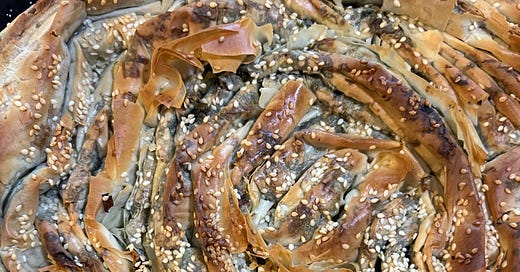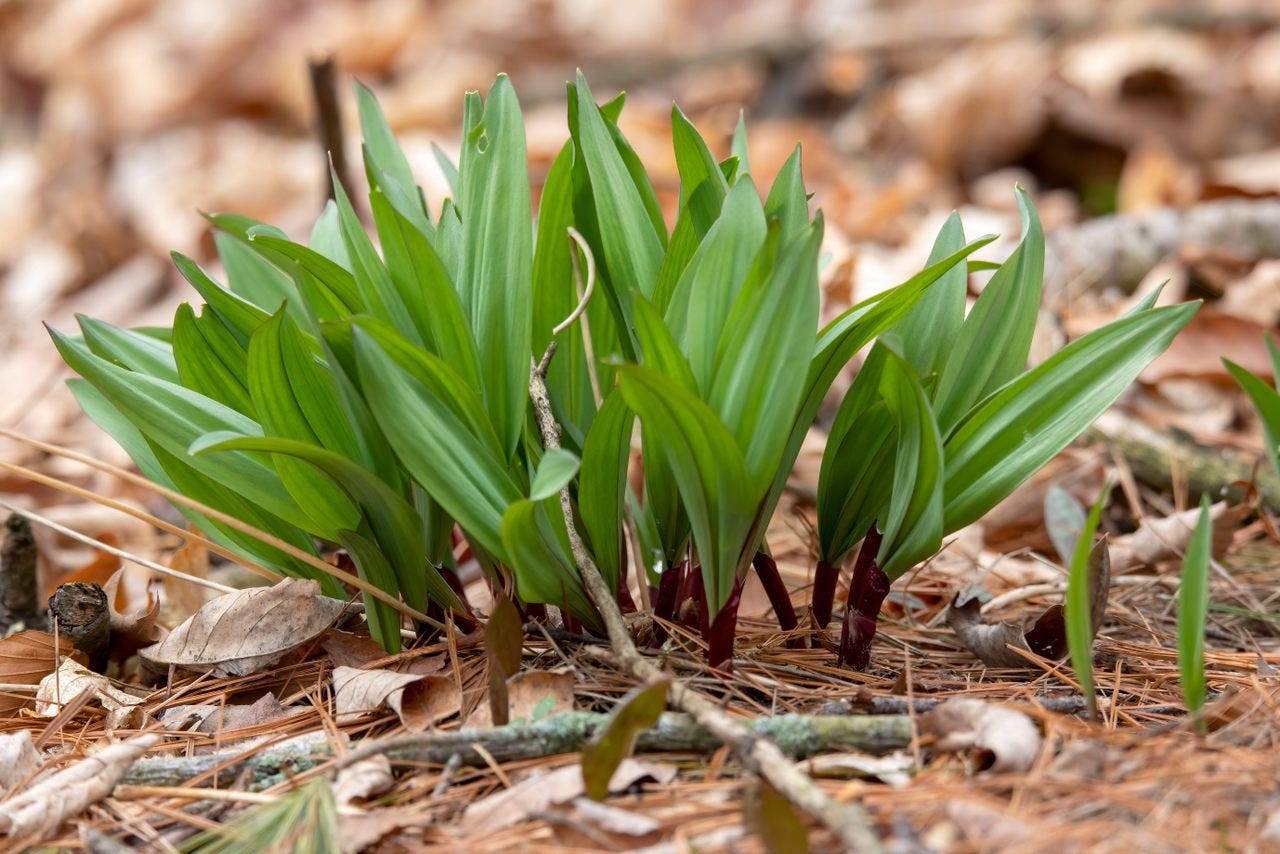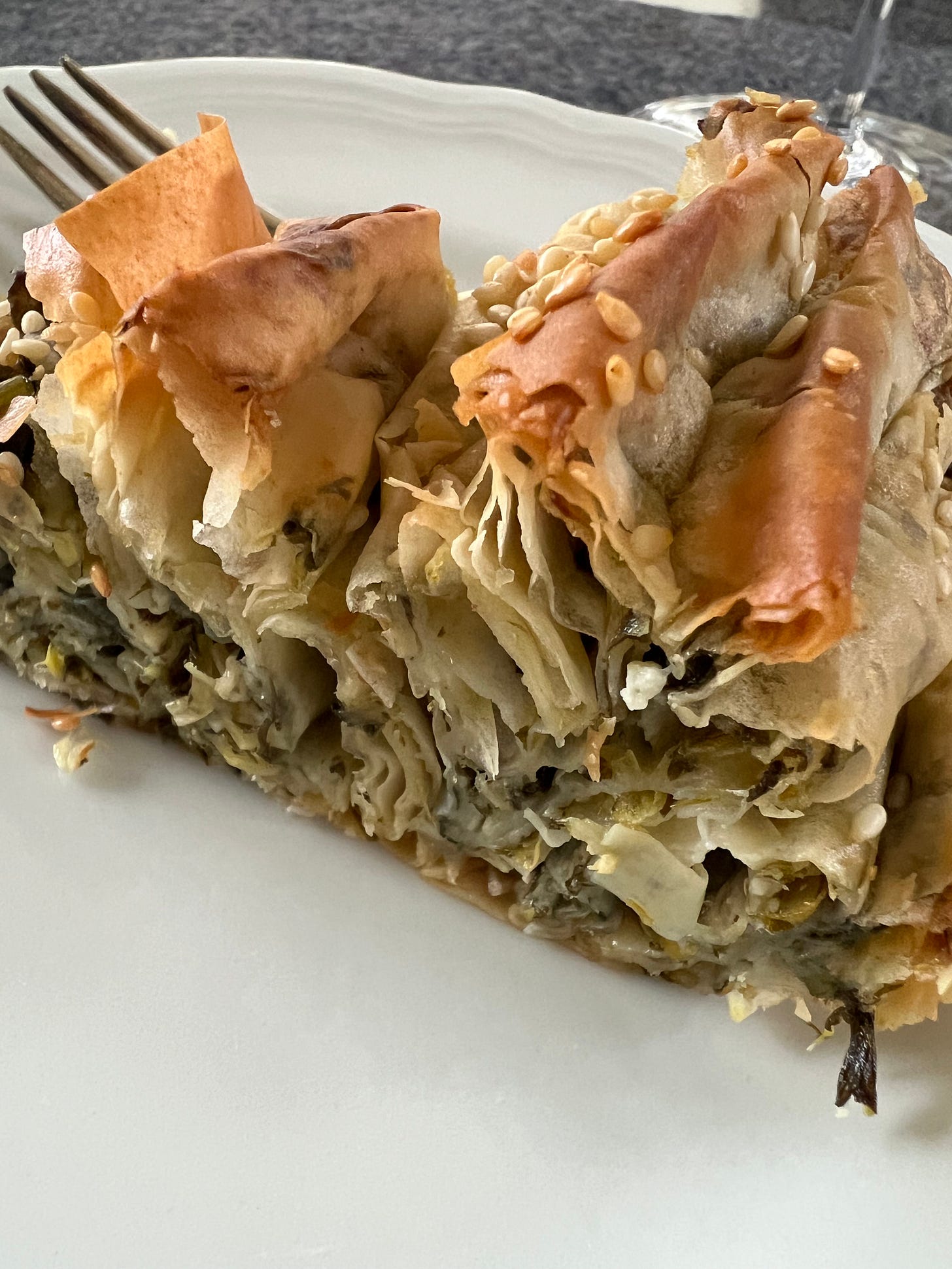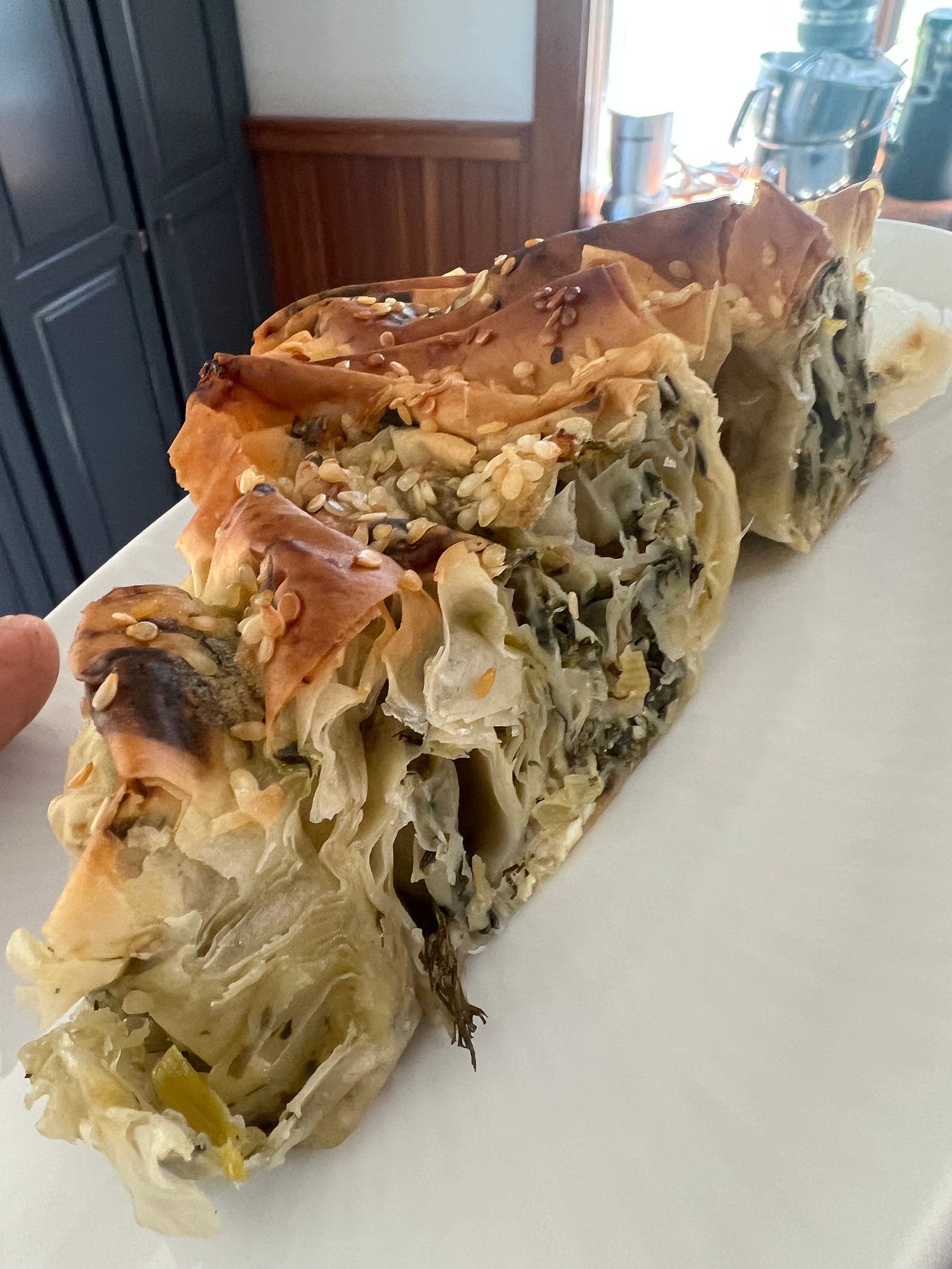Issue #153: Prasopita, A Greek Leek and Feta Pie
It's Ramps Season...Again, An Insta Recipe for a Savory Greek Pie Adapted to the Moment
As I’ve written before, I find it perennial amusing how on the first warm spring day, New York City’s Union Square Greenmarket is packed with people looking for fresh, seasonal vegetables. They’re either overly optimistic or agriculturally ignorant in thinking that one day of sunny warmth might miraculously break us free from the hibernal tyranny of shriveled root vegetables and wool.
Ramps bring the first real greenmarket joy. Sometimes referred to as wild leeks (perhaps incorrectly, I’ve learned), these pungent little alliums are the first culinary sign of spring. Their strong, funky flavor and stringy texture are not to everyone’s liking. I for one do not subscribe to the “everything is better with ramps in it” school of cooking. But I do love ramps in some things, always chopped up to address the textural challenge, usually sautéed, often scrambled with eggs that I top with melted Comté. In season, Nate and I eat this for breakfast more times than I would admit to my cardiologist.
Now that we live in the Upper Valley of New Hampshire, ramps season…er…I mean, spring, is coming later than I’m used to. So, I asked a couple of recent visitors from New York City to bring me a few bunches of ramps if they passed through the Union Square market.
Because our friends are overly generous, my fridge is full of ramps and their vernal cousins—green garlic, young leeks, spring onions—which everyone within a couple miles may know from the aroma that wafts out of the fridge every time I open the door. I am putting these early alliums into everything and anything that calls for onions or garlic and a few things that don’t.
I can’t really blame my friends because, I must admit, I usually buy more than I know what to do with on my own. Two years ago in this very newsletter I offered a recipe for ramp jam to address a similar surfeit. But how much ramp jam does anyone need? (I still have some vintage 2022 in my cupboard if you want some.)
Then the other day, an intriguing recipe crept into my Instagram feed. It was for a traditional Greek leek and feta pie known as prasopita, posted by an Australian phyllo company called Antoniou, made by a Greek woman named Artemis, who looked like she knew what she was doing.
Watching the video of Artemis making her prasopita and thinking about the alliums in my fridge recalled a distant memory of a visit to Crete, where almost everywhere we went we saw people foraging for wild vegetables in the hills on the side of the road. What self-respecting Greek cook wouldn’t prefer to make this pie with wild leeks and other spring onions, I thought? And that’s exactly what I set out to do.
Because my mind works in funny ways and my fridge is always overflowing, I had a fresh package of phyllo on hand. I’d been thinking lately I should play with phyllo more. I always have a hunk of sheep’s milk feta in brine in my fridge that gets funkier from month to month. (I’m sorry Greek friends, it’s actually from Bulgaria and so according to international law I’m supposed to just call it “white cheese.”) I also had a little cooked spinach and chard to use up and some near-death dill left over from the matzo ball soup I made for Passover. The resulting prasopita was both beautiful and delicious.
I tweaked the recipe to offer you this elegant spring pie. Echoing Artemis’s sesame-seed garnish, I served it with some lemony tahini sauce I also had on hand (see recipe, Issue #24). I suggest you do the same. Sure, the prasopita can be made any time of year with store-bought onions and leeks, as Artemis demonstrates. But if you make it right now with all the wild ramps and other spring alliums you can find, you will thank me.
RECIPE: Mitchell’s Savory Spring Greek Pie
Makes 1 pie, enough for 8 to 10 servings
1 pound (454 g) phyllo pastry, at room temperature.
About 1 1/4 cups extra-virgin olive oil, divided
1 medium yellow or white onion, finely diced
Sea salt
About 1/2 to 3/4 pound (225-350 g) assorted spring alliums, such as ramps, green garlic, young leeks, spring onions (aka scallions), or others, chopped, or 2 large leeks, white and light-green parts, diced
1/2 to 1 cup cooked, squeezed, and chopped spinach, chard, kale, or other greens (optional)
Freshly ground black pepper
5 ounces (150g) or so imported feta, preferably from Greece or Bulgaria
1/3 cup chopped flat-leaf parsley
1/3 cup chopped fresh dill
1/3 cup chopped fresh mint
1 egg, beaten
2 tablespoons sesame seeds (not toasted)
Whether it’s frozen or you’ve defrosted your phyllo in the fridge, take it out a couple of hours before you intend to use it so it can come to room temperature. Preheat the oven to 350°F. Grease a 10- or 11-inch round baking pan, preferably with slanted sides, with olive oil and line with a square sheet of parchment paper large enough to hang over the sides.
In a large frying pan set over medium-high heat, add a generous ¼ cup of olive oil. When hot, add the diced onion, season with a pinch of salt, and sauté 3 or 4 minutes until soft. Add the chopped alliums, another pinch of salt, and sauté until they have wilted and any liquid has evaporated. Add the chopped greens, if using, and continue sautéing until dry. Season with black pepper. Transfer this mixture into a medium mixing bowl and let cool. Add the crumbled feta along with the parsley, dill and mint. Add the beaten egg and mix well, making sure the herbs and feta are evenly distributed throughout the mixture.
Pour the remaining cup or so of olive oil into a small bowl and have a pastry brush and small offset spatula nearby. Unwrap and unfold the room temperature phyllo. On a large, clean work surface, carefully lay out a sheet of phyllo, long side facing you. Brush the entire sheet with olive oil. Lay a second sheet of phyllo on top and brush that with oil, too. Distribute about 4 tablespoons of the filling mixture around the phyllo and, using the offset spatula, spread it thinly around. Lay a third sheet of phyllo on top of the filling. Press it down and then brush with more oil.
Starting at the long side farthest away from you, scrunch up the stuffed stack of phyllo like an accordian until it’s all compact. Beginning at one end, roll it around itself to form a sort of rose (see Artemis’s IG video, above). Carefully transfer this rose to the center of the prepared pan. And repeat with the remaining phyllo and filling, coiling concentric circles of stuffed phyllo around that first piece in the center until the pan is full and all the filling and phyllo are gone. If you have one or two shots of phyllo left, just oil them and double them up. Brush the top with more olive oil and sprinkle with the sesame seeds.
Set the pie in the preheated oven and bake for 50 minutes or so, until browned and set. Turn up the oven to 425 and bake until the edges are nicely browned, about 5 to 7 minutes more. Remove from the oven and let cool for 10 minutes or to room temperature before serving—with some tahini sauce (see recipe), if you have it.
A Few Words about Working with Phyllo
Phyllo tears easily and dries out fast. Keep the sheets you aren’t using covered with a towel while you work. If the dough tears, just piece it together with a small overlap, using the oil as a kind of glue. Don’t skimp on the oil. Because the sheets in a package of phyllo tend to tear in the same place, alternate the direction in which you lay the sheets on top of each other so as to reinforce the seam. Phyllo is very forgiving, especially when it is brushed with enough fat and baked until crisp. The torn edges and other imperfections crisp up beautifully.









Ramps season in Maine too and you give me inspiration. Thank you, Mitchell, I'm not going to experiment with ramp jam but the prasopita sounds delicious and right for the season. Next let's talk about the correct way to harvest ramps to guarantee they'll be plenty more next year too.